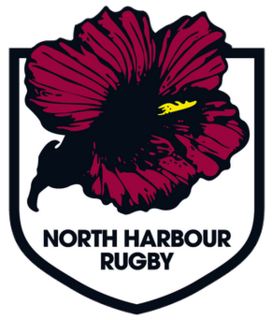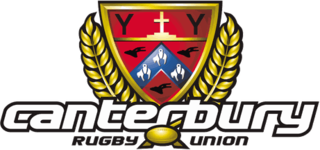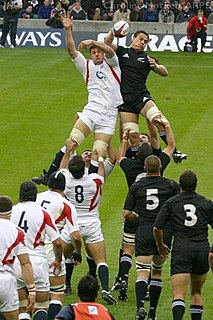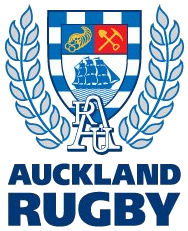
The Ranfurly Shield, colloquially known as the Log o' Wood, is a trophy in New Zealand's domestic rugby union competition. First played for in 1904, the Shield is based on a challenge system, rather than a league or knockout competition as with most football trophies. The holding union must defend the shield in challenge matches, which are played at the shield holders home venue, and if the challenger is successful in their challenge they will become the new holder of the Shield.

The North Harbour Rugby Union (NHRU), commonly known as North Harbour or simply Harbour, is the governing body of rugby union that encompasses a wide geographical area north of Auckland that includes North Shore City, Rodney District, the Hibiscus Coast and part of Waitakere City. There are 12 rugby clubs from Mahurangi RFC, based in Warkworth, Rodney District, in the north through to Massey the southernmost area of the union.

The Canterbury Rugby Football Union is the governing body for rugby union in a portion of the Canterbury region of New Zealand. Its colours are red and black in a hooped design. The CRFU govern the running of the Canterbury representative team which have won New Zealand's first-tier domestic competition National Provincial Championship 14 times including a "six-peat" from 2008 to 2013 – with five in the National Provincial Championship, two in the Air New Zealand Cup, five in the ITM Cup and one in the Mitre 10 Cup. Their most recent victory was the 2017 Mitre 10 Cup. Canterbury also acts as a primary feeder to the Crusaders, who play in the Super Rugby competition.
The 2006 Air New Zealand Cup was the inaugural season of the Air New Zealand Cup, contested by teams from New Zealand. The season ran from July to October 2006. At the end of the regular season, the top team from Repechage A and B joined with teams from the Top Six who entered the quarter-finals, with the winners going through to the semi-finals. The winner of each semi-final qualified for the final, which was contested between Waikato and Wellington, with Waikato winning 37–31 to win the first Air New Zealand Cup title.

The Tasman Rugby Union is the governing body for rugby union in Tasman Bay / Te Tai-o-Aorere, a bay at the north end of the South Island in New Zealand. Headquartered in Nelson, TRU is New Zealand's newest provincial union, founded in 2006 with the amalgamation of the existing Marlborough and Nelson Bays sub unions.

Rugby union is the unofficial national sport of New Zealand. The national team, the All Blacks, is currently ranked the second best international rugby team in the world, after South Africa. The sport has been known in New Zealand since 1870. The top domestic competitions are the semi-professional Mitre 10 Cup and amateur Heartland Championship, and above them Super Rugby, in which New Zealand has five franchises. The country co-hosted and won the first ever Rugby World Cup in 1987, and hosted and won the 2011 Rugby World Cup. They have won three World Cups, tied with South Africa, the most of any other country. They are also the current World Champions in 7s rugby for men and women.

The Auckland Rugby Union are a New Zealand governing body of rugby union in the New Zealand province of Auckland. The ARU governs the running of the Auckland representative team which have won New Zealand's first-tier domestic competition, National Provincial Championship 17 times—more than any other team. Their most recent victory was the 2018 competition. Auckland also acts as a primary feeder to the Blues, who play in the Super Rugby competition.

The Otago Rugby Football Union is the official governing body of rugby union for the Otago region of New Zealand. The union is based in the city of Dunedin, and its home ground is Forsyth Barr Stadium. The top representative team competes in the ITM Cup, New Zealand's top provincial competition. The union was to have been liquidated in March 2012. However a deal involving the Dunedin City Council allowed it to keep operating.

The Waikato Rugby Union (WRU) is the official governing body of rugby union in the Waikato area in the North Island of New Zealand. Headquartered in Hamilton, WRU was founded in 1921.

The Manawatu Rugby Football Union (MRU) is the governing body of the sport of rugby union in the Manawatū-Whanganui region of New Zealand.

The National Provincial Championship, or NPC, was the major domestic rugby competition in New Zealand. The NPC saw many alterations to its format and brand. Since 2006, it has been replaced by two competitions, the Mitre 10 Cup and the Heartland Championship. From the 2011 Season, the top Division was split into two tiers based on the 2010 Table after Pool Play. Teams 1–7 were assigned to the Premiership and teams 8–14 to the Championship. There is automatic Promotion/Relegation between the two tiers and also "crossover" matches, as well as full Round Robin Matches within each tier. The Heartland Championship is also split into two tiers after pool play with the top tier playing for the Meads Cup and bottom tier playing for the Lochore Cup. Currently, all 26 of New Zealand's Provincial Unions participate in either the Mitre 10 Cup or Heartland Championship. The NPC was first contested in 1976, and although the basic format of Division One was much the same from then until the 2006 reorganisation, there were a number of changes to the lower divisions.

The Heartland Championship competition, known for sponsorship reasons as the Mitre 10 Heartland Championship, is a domestic rugby union competition in New Zealand. It was founded in 2006 as one of two successor competitions to the country's former domestic competition, the National Provincial Championship (NPC). The country's 27 provincial teams were split into two separate competitions. Thirteen of the original teams, plus one merged side created from two other teams, entered the new top-level professional competition, the Air New Zealand Cup. The remaining 12 sides entered the new Heartland Championship, whose teams contest two distinct trophies, both named after legendary New Zealand players:
The 2009 Air New Zealand Cup was the 33rd provincial rugby union competition, the fourth since the competition reconstruction in 2006, involving the top 14 provincial unions in New Zealand. It ran for 15 weeks from 30 July to 7 November. It was also the last edition of the provincial competition to use the Air New Zealand Cup name, as the competition's sponsorship contract with Air New Zealand ended after that season. The 2010 competition will be held under a new name, the ITM Cup.
The 2009 Air New Zealand Cup was a provincial rugby union competition in New Zealand, which was run as a round-robin tournament from 30 July to 25 October. There were 13 rounds where every team played each other once. The top four teams on the Air New Zealand Cup table advanced to the semi-finals, where they played for a chance in the Grand Final.

Rugby union in New Zealand is structured into four tiers. The top tier is composed of the national representative teams, with the men's team – known as the All Blacks – at the top, followed by other representative sides such as the Junior All Blacks and Māori All Blacks. These national sides are administered by the New Zealand Rugby Union (NZRU). Below this level is Super Rugby, where there are five New Zealand sides, each representing a different region of the country. Below this level is provincial rugby, the third tier – each province has a representative side that plays in either the semi-professional Mitre 10 Cup, or amateur Heartland Championship. These provincial sides are selected of Super Rugby players, and club players from within the province. Club rugby is the fourth and lowest tier, and consists of clubs competing in local leagues organised by a provincial union.
The 2010 ITM Cup season was the fifth season since the competition reconstruction in 2006. For the ITM Cup competition it involved the top 14 provincial unions of New Zealand. The tournament was won by Canterbury, who defeated Waikato 33–13 in the competition final. For sponsorship reasons, the competition was known as the ITM Cup and it was currently the first season under the new sponsor. Including the defunct National Provincial Championship, this is the 34th season of New Zealand's premier domestic competition. The regular season matches took place from 29 July until 24 October – followed by the semi-finals that culminated in the final on 5 November.
The Counties Manukau Rugby Football Union (CMRFU) is the governing body of rugby union in Southern Auckland and the Franklin district of New Zealand. Nicknamed the Steelers, their colours are red, white, and black horizontal bands. The Steelers moniker is a reference to the Glenbrook steel factory, which is in the area. The union is based in Pukekohe, and plays at Navigation Homes Stadium.
The 2015 ITM Cup season was the 10th season of New Zealand's provincial rugby union competition since it turned professional in 2006. The regular season began on August 13, when Southland hosted a game against Auckland. It involved the top fourteen rugby unions of New Zealand. For sponsorship reasons, the competition is known as the ITM Cup and it is the sixth season under the lead sponsor. The winner of the Championship will be promoted to the Premiership, the 7th placed Premiership team will be relegated to the Championship.

The Farah Palmer Cup, is the highest level domestic women's rugby union competition in New Zealand and is named after the former Black Ferns captain, Farah Palmer. This contest is held annually from late August to early November and managed by the New Zealand Rugby Union, or NZRU. The competition was first introduced in 1999, with a total of fourteen teams competing initially. The number of teams increased to eighteen in the year 2000, but has decreased to as few as six teams, with 13 currently featured. Canterbury are the current holders of the JJ Stewart Trophy, the women's equivalent of the Ranfurly Shield. The Farah Palmer Cup is an amateur competition; players are not paid salaries and hold jobs outside of rugby.
The 2021 Mitre 10 Cup season is the 16th season of New Zealand's provincial rugby union competition since it became a 14 team tournament in 2006. The regular season does not currently have a scheduled start date. It involves the top fourteen provincial rugby unions of New Zealand. For sponsorship reasons, the competition is known as the Mitre 10 Cup and it is the sixth season under the lead sponsor. The winner of the Championship will be promoted to the Premiership, while the team that places last in the Premiership will be relegated.

















